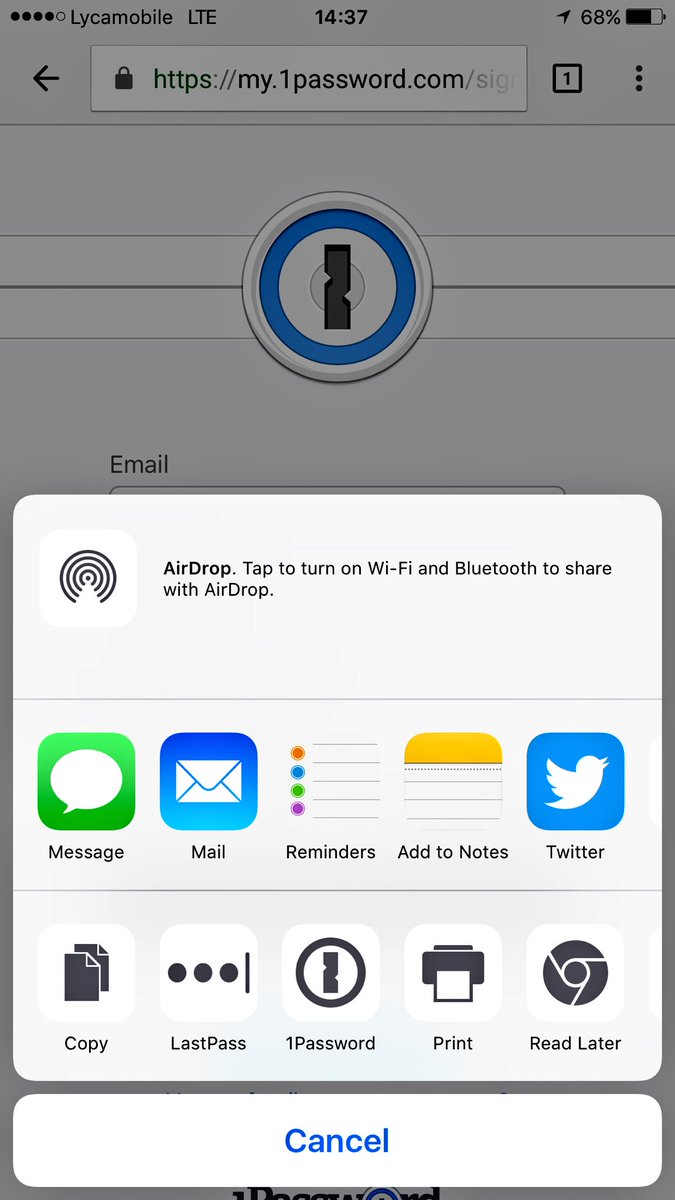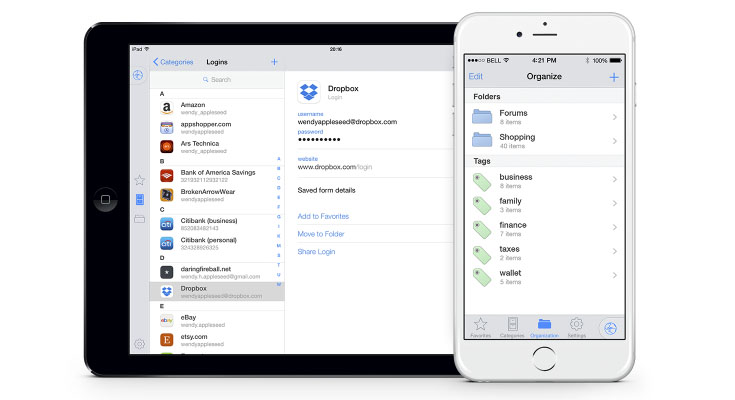Before you can use 1Password to fill and save your information, you’ll need to set up 1Password on your device. Then follow these steps: On the Home screen, tap Settings. Tap Passwords AutoFill Passwords. 1Password is available for all your computers, tablets, and phones, so you can manage your passwords, credit cards, secure notes, and more – wherever you are. I’m running iOS 14.0, (the real final but previously I ran the beta versions). I’m running the newest version of chrome, that allows default browser switching, but I have not been able to get 1password to work the way it does in Safari and other apps. The instructions for enabling it are old and don’t seem to match the current UI.
1Password works everywhere you do. Easily sign in to sites, use suggested passwords, and find what you need. Everything is available at your fingertips.
Get 1Password for:
If you’re using Safari, get to know 1Password for Safari.
Save a login
To save a login, enter your username and password. Then choose Save in 1Password.
To update an incorrect or incomplete login, make your changes, then choose Save in 1Password and click Update.
Fill logins and other items
To fill an item, click and choose it.
If 1Password suggests more than one item, you can use the arrow keys to select the one you want.
Or start typing to find it.
Use a suggested password
1Password suggests strong passwords when you’re changing a password or signing up for a new account.
To use a suggested password, click in a password field and choose Use Suggested Password.
Create a custom password
You can use the 1Password pop-up to create custom passwords. To open the pop-up, click in your browser’s toolbar.
To create a custom password, click and choose Password Generator.
Adjust the settings for your new password, then copy it to the clipboard or fill it on the page.
To see all the passwords you’ve created, click Generator History below the password generator.
Search 1Password
Searching is the fastest way to find what you need in 1Password.
To search in 1Password, open the pop-up and start typing.
To cancel the current search, clickor press Esc.
View and edit items
To view an item’s details, click it. Or use the arrow keys to select it.
To mark an item as a favorite, click .
To copy any field, click it.
To open the pop-up in a new window, click .
To show a field in large type, click to the right of it, then click Large.
To reveal a password, click to the right of it, then click Reveal. Or press Control-Option (or Ctrl + Alt) to reveal all passwords in the item details.
To edit an item, click Edit. The item will open in a new tab, where you can add tags or custom fields, move it, or delete it.
Use drag and drop to fill in apps
To fill in an app, drag your login details from 1Password to it. For example, drag your password to the password field in the app.
You can also use drag and drop in your browser. Fill answers to security questions, membership numbers, and more.
Fill two-factor authentication codes
You can use 1Password as an authenticator for a site that supports two-factor authentication. First, find the site on 2fa.directory and follow the instructions to turn on two-factor authentication for the site.
When you see a QR code for 1Password to scan, click to scan it.
1password Chrome Os
Switch accounts and vaults
To see a list of your accounts and vaults, click > Vaults.
To see everything, click All Vaults. To see only the items for a specific account or vault, click it.
To set which vaults are included when you view All Vaults, click next to All Vaults, then adjust the vaults under Accounts and Vaults.
Use Watchtower
Watchtower tells you about password breaches and other security problems on the websites you have saved in 1Password.
If any of your items require action, you’ll see an alert banner with more information at the top of the item in 1Password.
To get alerted when a website you have an account for is added to Watchtower, click > Settings. Then turn on “Watchtower alerts”.
Lock 1Password
When you’re done using 1Password in your browser, you can lock it. To lock 1Password, click > Lock 1Password.
1Password will automatically lock when:
- you quit the browser
- you don’t use your computer for a certain amount of time
- your computer sleeps
Manage your settings
To manage your settings, click > Settings. You’ll be able to:
- Change your auto-lock settings
- Check for vulnerable passwords
- Change the language
- Adjust the toolbar button appearance
- Change which item list 1Password opens with
- Allow notifications
- Set a keyboard shortcut to open the pop-up
- Adjust how 1Password behaves on web pages
- Add and remove accounts; adjust All Vaults
- Make 1Password the default password manager
Get help

If you don’t see the 1Password icon in your browser’s toolbar
If the 1Password icon is missing from your browser toolbar, you can customize the toolbar to make it visible.
If your browser’s built-in password manager is interfering with 1Password
If your browser’s built-in password manager is interfering with 1Password, you can turn it off. Click in your browser’s toolbar, then click > Settings, and turn on “Make 1Password the default password manager”.
If you use different passwords for additional 1Password accounts
When you unlock 1Password in your browser, only accounts using the same password are unlocked. To unlock an account that has a different password, lock 1Password, then unlock it using the password for that account.
To make sure you always have access to your 1Password accounts, use the same password for all of them. If you signed up for accounts with different passwords, you can change them.
Learn more
Set up AutoFill
Before you can use 1Password to fill and save your information, you’ll need to set up 1Password on your device. Then follow these steps:
- On the Home screen, tap Settings.
- Tap Passwords > AutoFill Passwords.
- Turn on AutoFill Passwords.
- Select 1Password.
From now on, you’ll be able to fill and save passwords, without ever opening the 1Password app.
Tip
To stop iCloud Keychain from asking to save your passwords, deselect iCloud Keychain. Then you’ll always know passwords are saved in 1Password, without any confusion.
Fill and save passwords
To fill or save a password, visit a website in Safari or open an app, and tap a username or password field. If you have a Login saved for the website or app, you’ll see your username above the keyboard. If not, you’ll see Passwords.
To fill a Login, tap your username above the keyboard. If you have more than one Login for the website or app, tap to choose a different one.
Save a Login
If you already have a username and password for the website, tap , then tap Create Login. Enter your details, then tap Save & Fill.
1password Download
If you don’t have a username and password for the website, tap , then tap Create Login. Enter a username, then tap Generate New Password to automatically create a strong password. If a website has specific password requirements, tap Show Password Recipe and adjust length, digits, and symbols. When you’re done, tap Save & Fill.

To change where Logins are saved, open 1Password, tap Settings > Vaults > All Vaults > Vault for Saving, and choose a vault.
Get help
AutoFill requires 1Password 7.2 or later.
If you can’t use Touch ID or Face ID with AutoFill, open the 1Password app and enter your Master Password to unlock it.
If you have a Login item in 1Password that doesn’t appear when you try to fill:
- in an app, tap Passwords to see all your Login items and choose the one you want to fill.
- in Safari, you may need to edit the item to make sure its website field matches the website.
If you recently changed an item on another device and the change isn’t appearing when you attempt to fill, open and unlock 1Password to sync your changes.
If you’re an iOS app developer, set up your app’s associated domains.

If you still need help, follow these steps:
- Make sure you have the latest version of iOS
- Make sure you have the latest version of 1Password.
- Make sure that you set up 1Password.
- Make sure that you set up AutoFill.
Learn more
- Use the 1Password extension to fill and save credit cards, addresses, and more
Next steps
You can also fill passwords:
